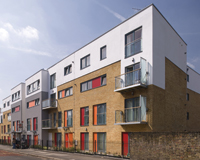 London mayor Sadiq Khan’s guidance on affordable housing commitments for residential development confirms a 35% level of affordable housing per scheme.
London mayor Sadiq Khan’s guidance on affordable housing commitments for residential development confirms a 35% level of affordable housing per scheme.
The Supplementary Planning Guidance, published this week, also includes a two-year start clause once planning is given, clarity around PRS requirements and a breakdown of the definition of affordable housing.
The guidelines confirm what Estates Gazette has reported over the preceding months: a fast-track planning process for developers if they achieve 35%, and a new classification for rental developments.
Deputy mayor for housing James Murray said: “The idea is to give applicants the incentive to go away from long negotiations about viability, speed up the process, and increase the amount of affordable housing.
“It’s a package that sets out more certainty wherever possible, and boosts overall supply as well as the number of affordable homes.”
Khan was elected with a manifesto pledge that 50% of all new housing would be affordable. However, he has since rowed back on this for private schemes, while intending to up the level of affordable on publicly owned sites.
Murray said the two options for developers will be known as Route A and Route B.
Route A is for schemes with less than 35% affordable housing, to which a standard viability assessment will apply. Schemes that propose a different affordable mix, or other concessions, such as a school, will require an assessment.
Route B is for schemes that meet that 35% requirement. This means no viability assessment, and a fast-track planning process. The affordable mix will need to be 30% affordable rent, 30% intermediate product (LLR or shared ownership), and another 40% that the local authority can decide.
The SPG applies to schemes of more than 10 units, while Estate Regeneration schemes will also be exempted.
Build-for-rent developments will be allowed to provide all units at discounted market rent, provided they meet a series of criteria. Levels of affordable will be defined through a viability assessment.
Potential call ins
Murray stressed that the guidelines were not policy. However, he said that boroughs and developers that did not comply ran the risk of referral to a mayoral decision.
“The idea is to set the standard for the way viability should be done,” he said. “Let’s say a plan is agreed by the local planning authority and the applicant at a percentage lower than 35%, and the mayor is not happy with the viability assessment. He can then consider what to do, and calling in is an option open to him.”
A clause for those that have fast-tracked viability will also state that units that do have not achieved a pre-agreed level of progress within two years will be eligible for review and higher affordable fees.
The guidelines state that the preferred method of measuring land value during viability assessments will be existing use value plus.
Furthermore, the GLA said that although there could be some concession to sites that had already been bought, what had been paid previously was not relevant.
A lack of national guidance
The guidance has been reliant on wider government policy, notably the Autumn Statement and housing white paper.
However, how starter homes fit into affordable and wider housing provision is still not known. “Whatever you know, we know,” said Murray.
“We will just be very honest in the draft, saying the policy on starter homes is not yet known and we will have to see how to amend this when it becomes clear.”
Affordable homes program 2016-21
The guidelines tie in with the Affordable Homes Programme 2016-21, which was also released. This sets out how the mayor intends to spend the £3.2bn announced in the Autumn Statement that will go towards the provision of 90,000 new affordable homes.
Around £2bn of this is actually new funding, though all of it will fall under the same guidelines and be used to support affordable housing from registered providers. The GLA has also been granted greater freedom in what kind of affordable product the money is allocated to.
Khan intends to fund 58,500 homes through a mix of London Living Rent and shared ownership and another 29,000 of affordable rent.
The three affordable products to be delivered are:
• London Affordable Rent: low-cost rented homes for households in most need, with benchmark rents published by city hall.
• London Living Rent – maximum rents set at 1/3 of average incomes, to help households save a deposit. Housing associations will be incentivised through the grant money to encourage saving.
• London Shared Ownership – a part-buy, part-rent product
See also:
Khan’s 35% affordable flat rate
TfL plan to meet affordable housing funding shortfall
• To send feedback, e-mail alex.peace@estatesgazette.com or tweet @egalexpeace or @estatesgazette










